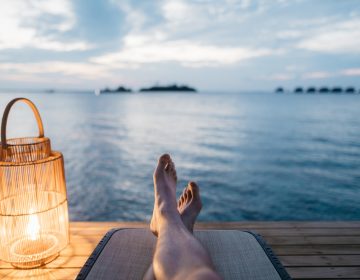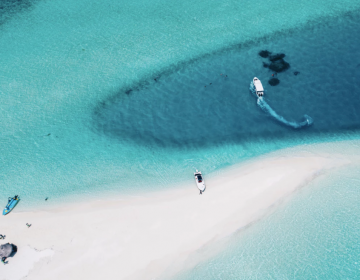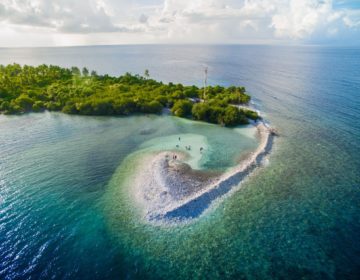North Maalhossmadulu Atoll Islands or Raa Atoll is an administrative division of the Maldives, which includes Northern Maalhosmadulu Atoll and the island of Alifushi. The capital is Ungoofaaru, and the main tourist resort islands are Loama Maamigili and Meedhupparu. Formerly this atoll was off-limits for tourists, but since the late 1990s, there was a change in government policy. Carpe Diem Beach Resort and Spa is considered as the most luxurious resort in the Atoll.

Eththigili
Eththigili is an uninhabited island at the very north of Raa Atoll that has a navigation light that marks the beginning of Allhuras Kandu.
Alifushi
Alifushi is an ancient inhabited island that is famous for its carpentry and boat building. It has a boat building yard and a dredged harbor, as well as good vegetation with banana and other fruit trees.
Vaadhoo
Vaa is a word meaning ‘jungle,’ but can also mean ‘flying bat’ after which the island is named. The Islanders are regarded as good fishermen, and they have access to excellent fishing grounds at the main entrance to the atoll.

Rasgetheemu
Ras means the beginning or first island and refers to its strategic position at the north of the atoll. Although the island is reputed to have been settled by the original inhabitants of the Maldives, there is no evidence of temples, like some of the other islands in the atoll. Rasge means ‘king,’ and theemu is an island. The island name is believed to have originated from the legendary story of the founder of the first ruling royal family. His name was Taya-Malla (Koimala’Kalo according to legend) who was the leader of a breakaway group of the Kalabhra people, who made their way to the Maldives from Madagascar in the 12th century AD. Taya-Malla wed the Ceylon king’s daughter and made a voyage with her in two vessels from Serendib Island. On reaching the Maldives, they were becalmed and rested at Rasgetheemu. Learning that the visitors were of royal descent, they were invited to stay and ultimately proclaimed their king. Subsequently, Taya-Malla migrated to Malé and settled there with the consent of the original inhabitants of the Maldives, the Giraavaru people.

Angolhitheemu
In old writings, the name means ‘slave island.’ According to legend, it is where the servants of the Royal couple who migrated from Ceylon were housed. In the local language, agholi means the island next to.

Hulhudhuffaaru
Hulhu means small, dhuh means can be seen, and faaru (not to be confused with faru) is a wound or injury. The island was inhabited by Buddhists long before Islam came to the Maldives and there is evidence of ruins. There are also some massive tombs of wealthy and influential people to be seen here. The island has a lovely lagoon and even before the coming of the Portuguese in the early 16th century, many ships trading in cowries and dried fish from Bengal, Arabia, and South East Asia were visiting here. The island became uninhabited and later re-inhabited.
Faarafushi, Gaaudoodhoo, Hulhudhoo, Lhanbugau
These are all uninhabited islands in the vicinity of Hulhudhuffaaru.
Maanenfushi
This is a proposed resort island.
Liboakandhoo
Liboakandhoo is an uninhabited island, but it was once inhabited. There are the ruins of a mosque, a bathing tank, and a cemetery.
Ifuru
Ifuru is quite a large uninhabited island, but it was once inhabited. On the north side of the island are the remains of what appears to have been a small minaret. It was quite common in the earlier days for many people of an island to suddenly die because of sickness and when the population declined those remaining would leave and join other islands. There was no need for permission from the government, so islands throughout the archipelago were continuously uninhabited re-inhabited.

Ugulu
Ugulu is an uninhabited island but was once inhabited. There is a large mound called Redhinge Usgada. The Redhin, but talked about in the Maldives as being the mythical original inhabitants of the islands, were believed to be fishermen from the coastal region of India. Redhinge became the Maldivian name for these early migrants.
Ungoofaru
Ungoofaru has been the capital of the atoll for a long time. It has the regional hospital, a youth stadium, and two communication towers. Two-thirds of the population from the island of Kandholhuldhoo were displaced after the tsunami and were temporarily housed here. Many will be replaced by the newly constructed island of Dhuvaafaru.
Lundhufushi
Lundhufushi is uninhabited, but a proposed island resort.
Dhuvaafaruhuraa
Dhuvaa means moving island. It is an uninhabited island that was once joined to Dhuvaarfaru.
Dhuvaafaru
Dhuvaafaru was once a big inhabited island until a cyclone came and separated the island into two. Dhandehelu, one of the heroes of the liberation of the Maldives from the Portuguese in 1573, was born on this island. He was the first mate of the Kalhuohfummi, the odi (boat) of Bodu Muhammed Thakurufaanu (Sultan Ghazi Muhammed Thakurufannu, 1573-1585) who led the successful rebellion against the Portuguese. Dhandehelu was a small boy of 12 years old when Bodu Thakurufannu saw him on the beach. He was a very active, cheerful lad who was always busy. During their first meeting, Dhandehelu is said to have been eating with one hand and fishing with the other. He became a devoted assistant of Bodu Thakurufaanu and was later buried in the same mosque in Malé. Dhuvaafaru is being built to accommodate inhabitants of Kandholhudhoo, displaced after the 2004 tsunami.

Maakurathu
This island is named after the 25th Sultan of the Maldives.
Kudakurathu
Kudakurathu is a sizeable uninhabited island on the outside of the atoll.
Muravandhoo
Muravandhoo is an uninhabited island that was once inhabited. On the south-west side of the island, there are the remains of a mosque with coral slabs. There are many small, uninhabited islands in the middle of the atoll that is often being eroded or built up according to the seasons. Some of them are Arilundhoo, Lundhufushi, Bodufenmaaeboodhoo, Hiraveri, Guboshi, Kudalhosgiri, Madivaafaru, Boduhaiykodi, Kudahaikodi, Dhikkuredhdhoo, Goyyafaru, Mahidhoo, Mullaafushi, Filaidhoo, Kottafaru, Kuroshgiri, Wakkuru, Dhigali, Ufulandhoo, Thaavathaa, Kukuhuldhoo, Lhohi, Maafaru, Aarah, Maafaru, Kuduthulaadhoo.
Rasmaadhoo
Rasmaadhoo is an uninhabited island which is known for its carpenters and boat builders. There are reputedly 70 small dhonis on the island and several large ones, many now being used by Pearl Island Resort.

Innamaandhoo
Innamaandhoo means ‘people living on an island.’
Vandhoo
Vandhoo is a long uninhabited island that used to inhabited. There are the remains of a mosque with a cemetery nearby. Van is a hollowed out coconut tree used for crushing husks of rice and grain. Two women use one pole each and alternately pound the seed.

Kottefaru and Neyo
These are small, uninhabited islands.
Dhoragali
This is an uninhabited island meaning stone doorway.
Bodufushi and Kudafushi
Bodufushi and Kudafushi were both inhabited in the 18th century, and both islands have the remains of magnificent mosques. The seventeenth sultan of the Maldives is buried on Bodufushi. At the time of his death, he was on an official visit to the atoll. At the time, the winds were unfavorable for a return to the island capital, so the officials collected sweet-smelling flowers and screw pine to spread around the boat so they could prevent the decaying body from smelling. The Sultan was buried at the mosque on Bodufushi, and his grave marked with a big headstone.

Iguraidhoo
Iguraidhoo is another inhabited island well known for its boat building.
Fainu
Fainu was the first island that the famous Arab traveler, Ibn Battuta, visited when he arrived in the Maldives. There is good anchorage, and in the past, this island was a major trading center with ships stopping here for trade in slaves, cowries, coir, and dried fish. It was the first port of call for ships coming to India during the northeast monsoon.
Kinolhas
Kinolhas is an inhabited island and the last of the bigger islands in the south of the atoll.
Meedhupparu
Meedhupparu is now a resort called Adaaran Select Meedhupparu. The original name when translated means ‘this is the island that someone saw.’
Furaveri
Furaveri is now a resort.
Meedhoo
Meedhoo has been inhabited for many centuries. The Islanders are boat builders and fishermen and enjoy a relatively high standard of living.

Boduhuraa
Boduhuraa is a long uninhabited island.
Dheburidheythereyvaadhoo
Dheburidheythereyvaadhoo is the longest island name in the Maldives. It means ‘the island of Vaadhoo lays between’ (Raa and Baa Atolls).
Huruvali, Viligili, Maamunagau, Maamunagaufinolhu, and Fenfushi
These are uninhabited islands at the southern end of the atoll.
Maduvvari
Madduvari is an inhabited island. Madu means layer, like the layers of planks on a boat and vari, means divorce.
Fasmendhoo
Fasmendhoo is an uninhabited island but was once inhabited by people.
Kothaifaru
Kothaifaru is uninhabited but was once inhabited. There are the remains of a mosque with two wells and a cemetery.
Maashigiri
Maashigiri is a small inhabited island on the western side of the atoll.
Bodufarufinolhu
Bodufarufinolhu is the most western island in the atoll and has a navigation light on it.
Lhaabugali
Lhaabugali small uninhabited island. Lhaabu is the rope or sling that toddy toppers (coconut tree climbers) use to climb trees.
Dhinnaafushi
Dhinnaafushi is uninhabited and means ‘the island that was given.’
Giraavaru
Giraavaru is uninhabited but was once inhabited. A number of ceramic plates were unearthed on this island in 1980.

Kandholhudhoo
Kandholhudhoo is not a large island, but it was the most populated island in the atoll before the 2004 tsunami. The population has now been relocated to other islands. Kandholhu is a wild lily. The inhabitants celebrated Kuda Eid (just after Ramadan) with a ceremony that reflected Hindu traditions from India and Buddhist origins similar to Burma. The people wore Kodi hats or umbrellas that were made on the island of Rasmaadhoo in the same atoll. They also practiced water throwing and even went so far as to throw their potential partners into the ocean when they were courting.
Badaveri
Badaveri is an uninhabited island. Bada means stomach and veri is its owner.
Vaffushihihuraa and Vaffushi
These are uninhabited islands. There is a navigation light on Vaffushi.
Maamigili
Maamigili was once inhabited. It is now a resort called Loama, and there are remains of a mosque and two wells on this island.

Uthurumaaafaru, Fuggiri, Ekurufushi, Kagoogadu, and Veyvah
These are uninhabited islands on the northeast of the atoll.
(Source: Dive Maldives: A guide to the Maldives Archipelago. Tim Godfrey. Atoll Editions)



